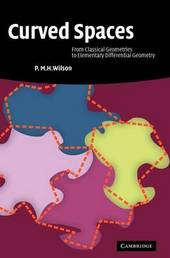
|
Curved Spaces: From Classical Geometries to Elementary Differential Geometry
Hardback
Main Details
| Title |
Curved Spaces: From Classical Geometries to Elementary Differential Geometry
|
| Authors and Contributors |
By (author) P. M. H. Wilson
|
| Physical Properties |
| Format:Hardback | | Pages:198 | | Dimensions(mm): Height 244,Width 170 |
|
| Category/Genre | Calculus and mathematical analysis |
|---|
| ISBN/Barcode |
9780521886291
|
| Classifications | Dewey:516.36 516.352 |
|---|
| Audience | | Tertiary Education (US: College) | | Professional & Vocational | |
|---|
| Illustrations |
Worked examples or Exercises; 79 Line drawings, unspecified
|
|
Publishing Details |
| Publisher |
Cambridge University Press
|
| Imprint |
Cambridge University Press
|
| Publication Date |
13 December 2007 |
| Publication Country |
United Kingdom
|
Description
This self-contained 2007 textbook presents an exposition of the well-known classical two-dimensional geometries, such as Euclidean, spherical, hyperbolic, and the locally Euclidean torus, and introduces the basic concepts of Euler numbers for topological triangulations, and Riemannian metrics. The careful discussion of these classical examples provides students with an introduction to the more general theory of curved spaces developed later in the book, as represented by embedded surfaces in Euclidean 3-space, and their generalization to abstract surfaces equipped with Riemannian metrics. Themes running throughout include those of geodesic curves, polygonal approximations to triangulations, Gaussian curvature, and the link to topology provided by the Gauss-Bonnet theorem. Numerous diagrams help bring the key points to life and helpful examples and exercises are included to aid understanding. Throughout the emphasis is placed on explicit proofs, making this text ideal for any student with a basic background in analysis and algebra.
Author Biography
Pelham Wilson is Professor of Algebraic Geometry in the Department of Pure Mathematics, University of Cambridge. He has been a Fellow of Trinity College since 1981 and has held visiting positions at universities and research institutes worldwide, including Kyoto University and the Max-Planck-Institute for Mathematics in Bonn. Professor Wilson has over 30 years of extensive experience of undergraduate teaching in mathematics, and his research interests include complex algebraic varieties, Calabi-Yau threefolds, mirror symmetry, and special Lagrangian submanifolds.
Reviews'... the patient reader will acquire substantial techniques and methods that are part of differential geometry and along with that, much, much more. ... The book is certainly a welcome addition to the literature. It is clear to the reviewer the the text is a labour of love' Mathematical Reviews 'This book paves its way through a number of geometries with a clear intent: to promote the understanding of the basic concepts in differential geometry. The classical 2-dimensional geometries such as Euclidean, spherical and hyperbolic geometry are the first few steps. The geometry of the torus, triangulations and Euler numbers are further issues. Every chapter is followed by an assortment of helpful examples. The chapters gently direct the reader [towards] Riemannian metrics and further to geodesics and abstract surfaces. The Theorema Egregium and Gauss-Bonnet Theorem are also given ample attention. What distinguishes this book from other lecture notes on elementary differential geometry? The author does not abruptly define concepts which otherwise never would have come to the reader's mind. He rather conveys the ideas, subtly initiated in the former chapters. In this sense the book is remarkably self-contained. On the other hand the author does not shun detailed proofs. All these ingredients make for a successful volume.' Johann Lang, Zentralblatt MATH 'Curved Spaces provides an elegant, sophisticated treatment of two-dimensional geometries suitable for advanced undergraduates ... Overall, Wilson has provided a monograph that could ably serve for an excellent undergraduate capstone experience ... Highly recommended.' S.J. Colley, CHOICE 'The book is written in a nice and precise style and explicit computations and proofs make the book easy to understand. A detailed and explicit discussion of the main examples of classical geometries contributes well to a better understanding of later generalisations. A list of examples at the end of each chapter helps as well. It is a very good addition to the literature on the topic and can be very useful for teachers preparing their courses as well as for students.' EMS Newsletter
|